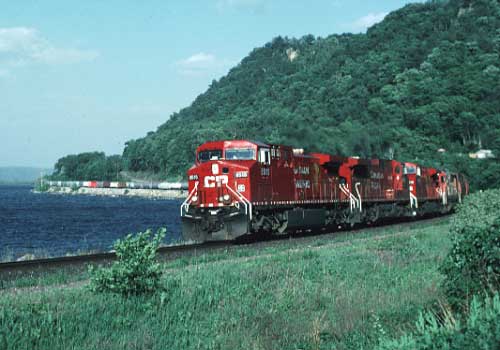CPR was Canada’s first transcontinental railroad, completed in 1885. The company expanded throughout the 20th century, developing energy, shipping, airline, and hotel businesses. Reorganized in 1971, the railway operated as a subsidiary of parent company Canadian Pacific, Ltd., until October 4, 2001, when it was spun off as a separate entity, the Canadian Pacific Railway.
CPR owns the 5,139-mile Soo Line Railroad, which runs from Chicago through Milwaukee and Minneapolis to Duluth and two points on the Canadian border, one near Winnipeg and one in Saskatchewan. In 1985 Soo bought the bankrupt Milwaukee Road, adding lines to Louisville, Ky. and Kansas City, and later began service to Detroit to reach southern Ontario. Soo has since sold most of its original lines in Wisconsin and northern Michigan, the Kansas City line, the Louisville line, and branches in North Dakota and Montana to new regional lines, including the line that reached Sault Ste. Marie, Mich., the city from which Soo derived its name. On May 26, 2005, CPR sold its route to Louisville (92 miles of track between Fayette and Bedford, Ind., plus trackage rights on CSX) to the Indiana Rail Road.
Long-time owner of 56% of the Soo Line, Canadian Pacific became its full owner in 1990. Although the Soo technically remains a separate corporation, it is operated as part of the CPR system.
CPR’s lines in the eastern U.S. belong to the Delaware & Hudson, which dates from 1823 and claims to be the country’s oldest continuously operating transportation company.
D&H operated a 1,500-mile system from Montreal to Philadelphia and Washington and Buffalo/Niagara Falls to New York. CPR purchased the bankrupt D&H from Guilford Transportation Industries in January 1991. In 1996, CPR created subsidiary St. Lawrence & Hudson to operate the D&H and its own lines between Quebec City, Montreal, Toronto and Chicago. St.L&H began operations on October 1, 1996, but was integrated back into the CPR system as the railway’s Eastern Network on December 1, 2000. In a further reorganization, CPR placed the D&H under direct control of the Soo Line on October 5, 2001.
Like its parent company Soo Line, operations on the Delaware & Hudson are integrated into CPR’s rail system.
Commodities
Rail traffic on Canadian Pacific is heaviest between Calgary and Vancouver, where unit trains filled with export coal and grain roll west to the Roberts Bank and Pacific Coast terminals. Grain from Canada and the U.S. also travels to domestic processors and the Great Lakes port of Thunder Bay, Ontario. Other bulk commodities that cross western Canada in significant quantities include sulfur, potash, fertilizer, and chemicals.
CPR serves online coal mines in western Canada, and Powder River Coal is received from UP and BNSF and delivered to utilities in the Upper Midwest and Canada.
Phosphate from Alberta is delivered to terminals on the Mississippi River or other U.S. railroads. Fertilizer and potash from western Canada move to the Pacific Coast, Canadian customers, or interchange points at Chicago and St. Paul, Minn.
CPR hauls manufactured goods east in general freight and intermodal trains to reach the consumer markets of New York, Philadelphia, and New England.
Intermodal trains operate between the port of Vancouver and the metropolitan areas of Chicago, Toronto and Montreal. CPR’s Expressway intermodal trains make two round trips six days a week between Montreal, Toronto and Detroit.
Headquarters:
Canadian Pacific Railway
Suite 500
401 9th Avenue, SW
Gulf Canada Square
Calgary, Alberta
T2P 4Z4
(403) 319-7000
www.cpr.ca














